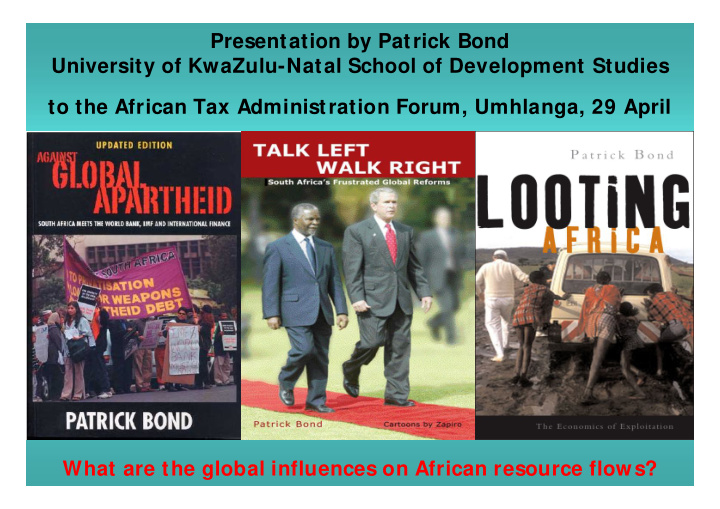



Presentation by Patrick Bond University of KwaZulu-Natal School of Development Studies to the African Tax Administration Forum, Umhlanga, 29 April What are the global influences on African resource flows?
Slowdown in world GDP growth
Especially low growth since 1980, and extremely uneven development 10% • Dramatic Annual percent growth in GDP per capita over the given period differences in 1970-1980 5% annual % change of 1980-2000 per capita 0% GDP (note: constant 1995$, not -5% PPP values) Source: Alan Freeman M ajor industrial countries -10% O ther advanced economies GDP per capita in 1995 dollars, 1982-2000 Developing 1982 2000 Countries in Transition 1,457 1,116 Rest of the World -15% 15,383 26,134 Advanced or Advancing Countries
How US economy fooled economists and investors for 20 years • Low interest rate • Low inflation rate • Low unemployment source: US Fed, Gagnon, 2009
How US economy fooled economists and investors • steady GDP • rising stock market • recovery from currency volatility source: US Fed, Gagnon, 2009
Root crisis process: source of declining US profits during globalisation era US corporate profits derived much less from manufacturing products; much greater sources of profits came from abroad; profits also came more from returns on financial assets. Source: Gerard Dumenil and Dominique Lev y
US economy becomes debt-addicted from early 1980s (source: John Bellamy Foster and Fred Magdoff, 2009)
‘hollowing corporations’ from mid-1980s (source: John Bellamy Foster and Fred Magdoff, 2009)
Ugandan political economist Dani Nabudere’s thesis vindicated The Crash of I nternational Finance Capital and The Rise and Fall of Money Capital
Production crash in historical terms Initially as bad as 1929 Source: Eichengreen and O’Rourke
Crash in US employment Source: DeLong
Trade crash in historical terms A worse crisis than 1929! Initially worse than 1929 Source: Eichengreen and O’Rourke
Volatility inexorably worsens (source: Unctad 2009)
Stock market crash in historical terms Initially worse than 1929 Source: Eichengreen and O’Rourke
US stock market crash Source: DeLong
Stock market volatility: all markets in ‘08 … widespread, dramatic loss of paper wealth Source: Unctad
Housing devaluations: Change in prices, Jan 2007- July 2008 … and the bursting of the bubble began in the US, Japan, Denmark and Ireland in 2007… Source: IMF, World Economic Outlook, October 2008
Commodity devaluations: Change in prices, July – December 2008 … particularly devastating for African countries addicted to export-led extractive-industry ‘growth’… Source: Unctad, The Global Economic Crisis, May 2009
2008-09 crisis killed employment, commodity prices and consumer confidence (though Keynesian policies restored GDP and trade may have partly recovered)
Keynes, PLEASE HELP! … note that North is allowed to do deficits, but South is discouraged …
Much lower interest rates, much higher deficits
Crisis and bailout (Calculations from Brad DeLong, April 2010)
African inequality: Gini coefficients the highest in the world Source: World Bank WDR 2006 Gini coefficient: 0 .2 .4 .6
World Bank method for adjusting savings to account for a country’s tangible wealth and resource depletion: The case of Ghana, 2000 (per capita US$ measure)
Where is Africa’s wealth? World Bank recording of African countries’ adjusted national wealth and ‘savings gaps’, 2000
UNCTAD explains transfer pricing: on $2000 sale, tax = $226
AI D: Declining commitments Source: World Development Movement
Aid in context: Far less than military spending Source: UNDP HDR 2005
Aid: Rhetoric and reality Source: World Development Movement
Phantom aid Source: World Development Movement
Capital flight from Africa 1970-2004, Source: Leonce Ndikumana and James Boyce, Univ of Mass.
Exchange controls needed Tanzania, Rwanda and Kenya were far less dependent, volatile
Recommend
More recommend